Morphodynamics and Successional Characteristics of Bowl Blowout in the Late Stage of Coastal Foredune
Abstract
1. Introduction
2. Materials and Methods
2.1. Study Area
2.2. Methods
2.2.1. Field Topographic Survey and Laboratory Analysis
2.2.2. Field Airflow Observation and Laboratory Analysis
2.2.3. Field Sediment Sampling and Laboratory Analysis
3. Results
3.1. Morphological Changes and Erosion-Accumulation Patterns of Bowl Blowout
3.1.1. Morphological Changes of Bowl Blowout
3.1.2. Erosion–Accretion Changes of Bowl Blowouts
3.2. Airflow Field Changes
3.2.1. Reference Station Wind Conditions
3.2.2. Wind Direction Changes Within the Bowl Blowout
3.2.3. Airflow Changes Within the Blowout
3.3. Sediment Grain Size Characteristics
4. Discussion
4.1. The Impact of Sediment Transport Environment on the Tannan Bay Blowouts
4.2. Feedback Mechanism Between Blowout Airflow and Morphology
4.3. Discussion on the Development Stage of Bowl Blowout
5. Conclusions
- (1)
- During the topographic survey period, the bowl blowout exhibited no significant morphological changes from survey 1 to survey 2. From survey 2 to survey 5, a clear landward retreat trend of the foredune at the entrance of the bowl blowout was observed, with no significant changes on the west lateral wall and a significant expansion trend on the east lateral wall. During this period, typhoons were the primary influence. Based on the erosion and accretion patterns between survey 1 and survey 2, significant accumulation occurred in the deflation basin, and minor erosion was observed on the lateral walls. Since survey 2, continuous aeolian accretion was in the deflation basin, while erosion was on the lateral walls. The maximum erosion depth on the eastern wall reached 3.99 m.
- (2)
- Under different wind directions, the wind speed at various parts of the blowout remained relatively stable, with small variability and change ranges. The wind direction was also stable throughout the blowout. The airflow speed within the blowout was lower than the reference wind speed, and the relative acceleration rate exhibited a more significant negative feedback effect from the entrance to the exit of the blowout. The wind speed at the entrance of the blowout ranged from 89.46% to 90.25% of the wind speed at the beach reference station, and the wind speed at the exit of the blowout ranged from 57.57% to 67.66% of the incoming wind speed. In addition, this study found that the wind direction and morphology of the blowout have a pronounced impact on the airflow characteristics within the blowout, and the distribution of airflow within the blowout also affects the development of the blowout morphology.
- (3)
- The bowl blowout investigated in this study is larger, with a deepening morphology and airflow acceleration. The sediment particles primarily consist of medium to coarse sand. The deflation basin is dominated by accumulation, and multiple shrub dunes are distributed in the front half of the deflation basin. The blowout height is 0.5 to 1.5 m lower than the backshore height. The front half consists of shrub dunes, and the lateral wall areas are extensively covered with Spinifex littoreus and Ipomoea pes-caprae (L.) R. Br., indicating that the bowl blowout has reached the late stage of its life cycle and is classified as depth-limited. Therefore, it cannot evolve into a trough blowout. In addition, influenced by typhoons, the lateral walls of the bowl blowout in the late stage continue to expand through erosion without reaching a critical size for the blowout.
Author Contributions
Funding
Data Availability Statement
Conflicts of Interest
References
- Hesp, P.A. Foredunes and blowouts: Initiation, geomorphology and dynamics. Geomorphology 2002, 48, 245–268. [Google Scholar] [CrossRef]
- Hesp, P.A.; Hyde, R. Flow dynamics and geomorphology of a trough blowout. Sedimentology 1996, 43, 505–525. [Google Scholar] [CrossRef]
- Luo, W.; Wang, Z.; Lu, J.; Yang, L.; Qian, G.; Dong, Z.; Bateman, M.D. Mega-blowouts in Qinghai–Tibet Plateau: Morphology, distribution and initiation. Earth Surf. Process. Landf. 2018, 44, 449–458. [Google Scholar] [CrossRef]
- Smyth, T.A.G.; Jackson, D.; Cooper, A. Airflow and aeolian sediment transport patterns within a coastal trough blowout during lateral wind conditions. Earth Surf. Process. Landf. 2014, 39, 1847–1854. [Google Scholar] [CrossRef]
- Smyth, T.A.G.; Jackson, D.W.T.; Cooper, A. Three dimensional airflow patterns within a coastal trough-bowl blowout during fresh breeze to hurricane force winds. Aeolian Res. 2013, 9, 111–123. [Google Scholar] [CrossRef]
- Zhou, Y.; Hasi, E.; Wang, Z.; Qing, D.; Han, X.; Yin, J.; Wu, Z. Dynamics of blowouts indicating the process of grassland desertification. Land Degrad. Dev. 2022, 33, 2885–2897. [Google Scholar] [CrossRef]
- Pye, K. Morphological development of coastal dunes in a humid tropical environment, Cape Bedford and Cape Flattery, North Queensland. Geogr. Ann. Ser. A-Phys. Geogr. 1982, 64, 213–227. [Google Scholar] [CrossRef]
- Jungerius, P.D. A simulation model of blowout development. Earth Surf. Process. Landf. 1984, 9, 509–512. [Google Scholar] [CrossRef]
- Byrne, M.L. Seasonal sand transport through a trough blowout at Pinery Provincial Park, Ontario. Can. J. Earth Sci. 1997, 34, 1460–1466. [Google Scholar] [CrossRef]
- Mir-Gual, M.; Pons, G.X.; Martín-Prieto, J.Á.; Roig-Munar, F.X.; Rodríguez-Perea, A. Geomorphological and ecological features of blowouts in a western Mediterranean coastal dune complex: A case study of the Es Comú de Muro beach-dune system on the island of Mallorca, Spain. Geo-Mar. Lett. 2013, 33, 129–141. [Google Scholar] [CrossRef]
- Hesp, P.A.; Hilton, M.; Konlecher, T. Flow and sediment transport dynamics in a slot and cauldron blowout and over a foredune, Mason Bay, Stewart Island (Rakiura), NZ. Geomorphology 2017, 295, 598–610. [Google Scholar] [CrossRef]
- Zhou, Y.; Wang, Z.; Qing, D. Morphological changes and dynamic mechanism of blowouts on fixed dunes in the Otingdag sandy land, China. China J. Sci. Bull. 2023, 68, 1298–1311. (In Chinese) [Google Scholar] [CrossRef]
- Łabuz, T.A.; Grunewald, R.; Bobykina, V.; Chubarenko, B.; Česnulevičius, A.; Bautrėnas, A.; Morkūnaitė, R.; Tõnisson, H. Coastal Dunes of the Baltic Sea Shores: A Review. Quaest. Geogr. 2018, 37, 47–71. [Google Scholar] [CrossRef]
- Smyth, T.; Fox, B.; Rooney, P.; Bodenbender, B.; De Vries-Zimmerman, S.; O’Keeffe, N. Patterns and controls of topographic change within the deflation basins of a trough and bowl coastal blowout. Earth Surf. Process. Landf. 2024, 49, 3737–3749. [Google Scholar] [CrossRef]
- Smith, A.; Gares, P.A.; Wasklewicz, T.; Hesp, P.; Walker, I.J. Three years of morphologic changes at a bowl blowout, Cape Cod, USA. Geomorphology 2017, 295, 452–466. [Google Scholar] [CrossRef]
- Gares, P.A. Topographic changes associated with coastal blowouts at Island Beach state park, New Jersey. Earth Surf. Process. Landf. 1992, 17, 589–604. [Google Scholar] [CrossRef]
- Talavera, L.; Costas, S.; Ferreira, S. Controls on blowout evolution in southern Portugal: A 49-year analysis. Sci. Total Environ. 2024, 955, 176769. [Google Scholar] [CrossRef]
- Gares, P.A.; Nordstorm, K.F. A cyclic model of foredune blowout evolution for a leeward coast, Island beach, New Jersey. Ann. Assoc. Am. Geogr. 1995, 85, 1–20. [Google Scholar]
- Barchyn, T.E.; Hugenholtz, C.H. Dune field reactivation from blowouts: Sevier Desert, UT, USA. Aeolian Res. 2013, 11, 75–84. [Google Scholar] [CrossRef]
- Fraser, G.S.; Bennett, S.W.; Olyphant, G.A.; Bauch, N.J.; Ferguson, V.; Gellasch, C.A.; Millard, C.L.; Mueller, B.; O’Malley, P.J.; Way, J.N.; et al. Windflow circulation patterns in a coastal dune blowout, south coast of Lake Michigan. J. Coast. Res. 1998, 14, 451–460. [Google Scholar]
- Barchyn, T.E.; Hugenholtz, C.H. Reactivation of supply-limited dune fields from blowouts: A conceptual framework for state characterization. Geomorphology 2013, 201, 172–182. [Google Scholar] [CrossRef]
- Carter, R.W.G.; Hesp, P.A.; Nordstrom, K. Erosional landforms in coastal dunes. In Coastal Dunes: Form and Process; Nordstrom, K., Psuty, N., Carter, R.W.G., Eds.; John Wiley and Son: Brisbane, Australia, 1990; pp. 217–250. [Google Scholar]
- Miyanishi, K.; Johnson, E.A. Coastal dune succession and the reality of dune processes. In Plant Disturbance Ecology: The Process and the Response; Johnson, E.A., Miyanishi, K., Eds.; Academic Press: San Diego, CA, USA, 2007; pp. 249–282. [Google Scholar]
- Abhar, K.C.; Walker, I.J.; Hesp, P.A.; Gares, P.A. Spatial-temporal evolution of aeolian blowout dunes at Cape Cod. Geomorphology 2015, 236, 148–162. [Google Scholar] [CrossRef]
- Smyth, T.A.; Hesp, P.A.; Walker, I.J.; Wasklewicz, T.; Gares, P.A.; Smith, A.B. Topographic change and numerically modelled near surface wind flow in a bowl blowout. Earth Surf. Process. Landf. 2019, 44, 1988–1999. [Google Scholar] [CrossRef]
- Yang, L.; Dong, Y.; Huang, D. Morphological Response of Coastal Dunes to Typhoons and Winter Monsoons on Pingtan Island, China. J. Mar. Sci. Eng. 2024, 12, 1758. [Google Scholar] [CrossRef]
- Zhang, S.Y. Morphological Changes and its Dynamic Mechanism of Blowout in Coastal Foredune: A Case Study in Pingtan Island, China; Sun Yat-sen University: Guanzhou, China, 2022. (In Chinese) [Google Scholar]
- Chen, F.; Li, Z.G.; Wang, R.G.; Wang, R.K.; Zhang, W.K. Characteristics of grain size distribution of surface eolian sands in Haitan island, Fujian. J. Appl. Oceanogr. 1993, 12, 385–392. (In Chinese) [Google Scholar]
- He, Y.; Liu, J.; Cai, F.; Li, B.; Qi, H.; Zhao, S. Aeolian sand transport influenced by tide and beachface morphology. Geomorphology 2022, 396, 107987. [Google Scholar] [CrossRef]
- Huang, D.Q.; Dong, Y.X.; Ha, S.; Ma, J. The application of multi-station RTKGPS in the survey of coastal dune. Acta Sci. Nat. Univ. Sunyatseni 2007, 46, 121–124. (In Chinese) [Google Scholar]
- Zhang, S.; Qiu, X.; Fu, S.; Fu, J.; Chen, S.; Tian, W.; Huang, D.; Dong, Y. Evolution of blowouts in artificial foredunes on Pingtan Island, China. Earth Surf. Process. Landf. 2022, 47, 2597–2611. (In Chinese) [Google Scholar] [CrossRef]
- Jackson, P.S.; Hunt, J.C.R. Turbulent wind flow over a low hill. Q. J. R. Meteorol. Soc. 1975, 101, 929–955. [Google Scholar] [CrossRef]
- Hugenholtz, C.H.; Wolfe, S.A. Form- flow interactions of an aeolian saucer blowout. Earth Surf. Process. Landf. 2009, 34, 919–928. [Google Scholar] [CrossRef]
- Walker, I.J.; Nickling, W.G. Simulation and measurement of surface shear stress over isolated and closely spaced transverse dunes in a wind tunnel. Earth Surf. Process. Landf. 2003, 28, 1111–1124. [Google Scholar] [CrossRef]
- Wu, Z.; Huang, S.; Hu, S.Z.; Wu, K.G.; Jin, Z.M.; Zhu, Y. Research on the Landforms of the Wind-drift Sand in South China Coast; Science Press: Beijing, China, 1995. (In Chinese) [Google Scholar]
- Jungerius, P.D.; Witter, J.V.; van Boxel, J.H. The effects of changing wind regimes in the development of blowouts in the coastal dunes of The Netherlands. Landsc. Ecol. 1991, 6, 41–48. [Google Scholar] [CrossRef]
- Hesp, P.A.; Pringle, A. Flow behaviour in a trough blowout. Tangimoana, New Zealand. J. Coast. Res. 2001, 34, 597–601. [Google Scholar]
- Pease, P.; Gares, P. The influence of topography and approach angles on local deflections of airflow within a coastal blowout. Earth Surf. Process. Landf. 2013, 38, 1160–1169. [Google Scholar] [CrossRef]
- Jerolmack, D.J.; Ewing, R.C.; Falcini, F.; Martin, R.L.; Masteller, C.; Phillips, C.; Reitz, M.D.; Buynevich, I. Internal boundary layer model for the evolution of desert dune fields. Nat. Geosci. 2012, 5, 206–209. [Google Scholar] [CrossRef]
- Hugenholtz, C.H.; Wolfe, S.A. Morphodynamics and climate controls of two aeolian blowouts on the northern Great Plains. Earth Surf. Process. Landf. 2006, 31, 1540–1557. [Google Scholar] [CrossRef]
- Zhang, S.; Dong, Y.Y.; Hasi, E.; Huang, D.Q. Morphodynamics and morphological evolution characteristics of blowouts dunefields: A case study in Haitan Island, Fujian. Geogr. Res. 2024, 43, 255–271. (In Chinese) [Google Scholar]
- Yang, L.; Dong, Y.X.; Huang, D.Q. Morphological change of coastal climbing dunes in Pingtan Island of China after typhoon group. J. Desert Res. 2020, 40, 1–8. (In Chinese) [Google Scholar]
- Hesp, P.A.; Walker, I.J. Coastal Dunes. In Treatise on Geomorphology; Shroder, J.F., Ed.; Academic Press: San Diego, CA, USA, 2013; Volume 11, pp. 328–355. [Google Scholar]
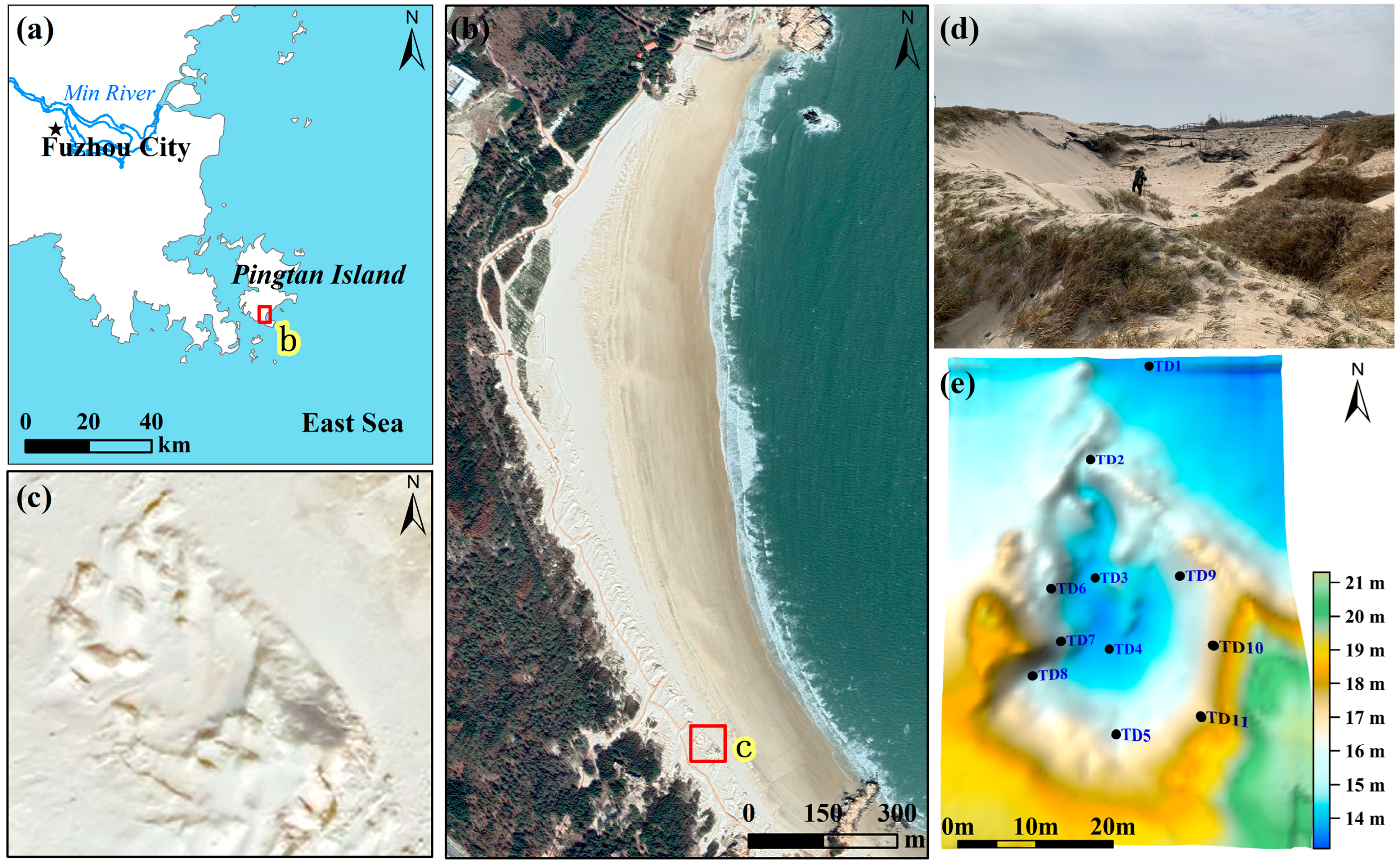
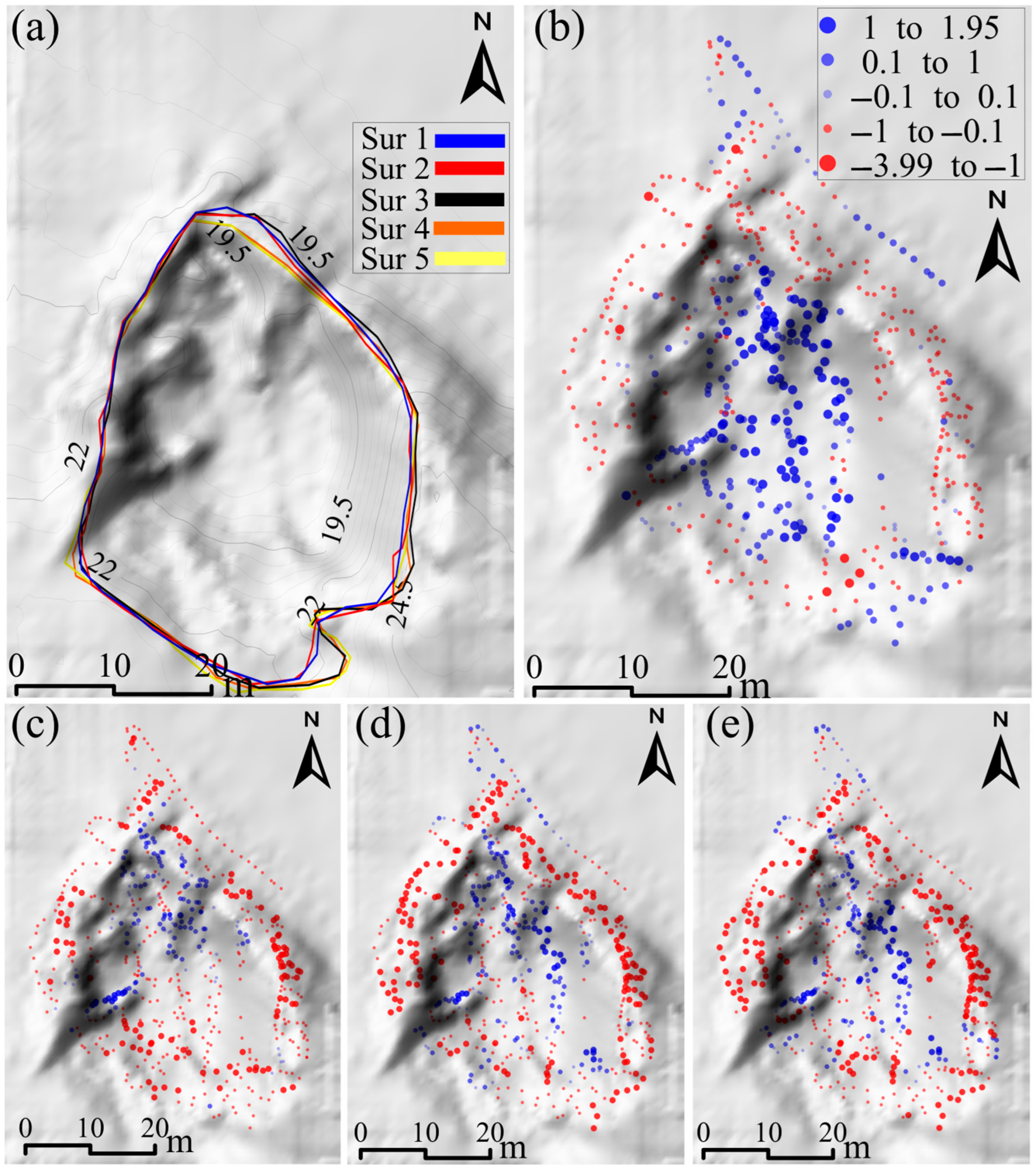
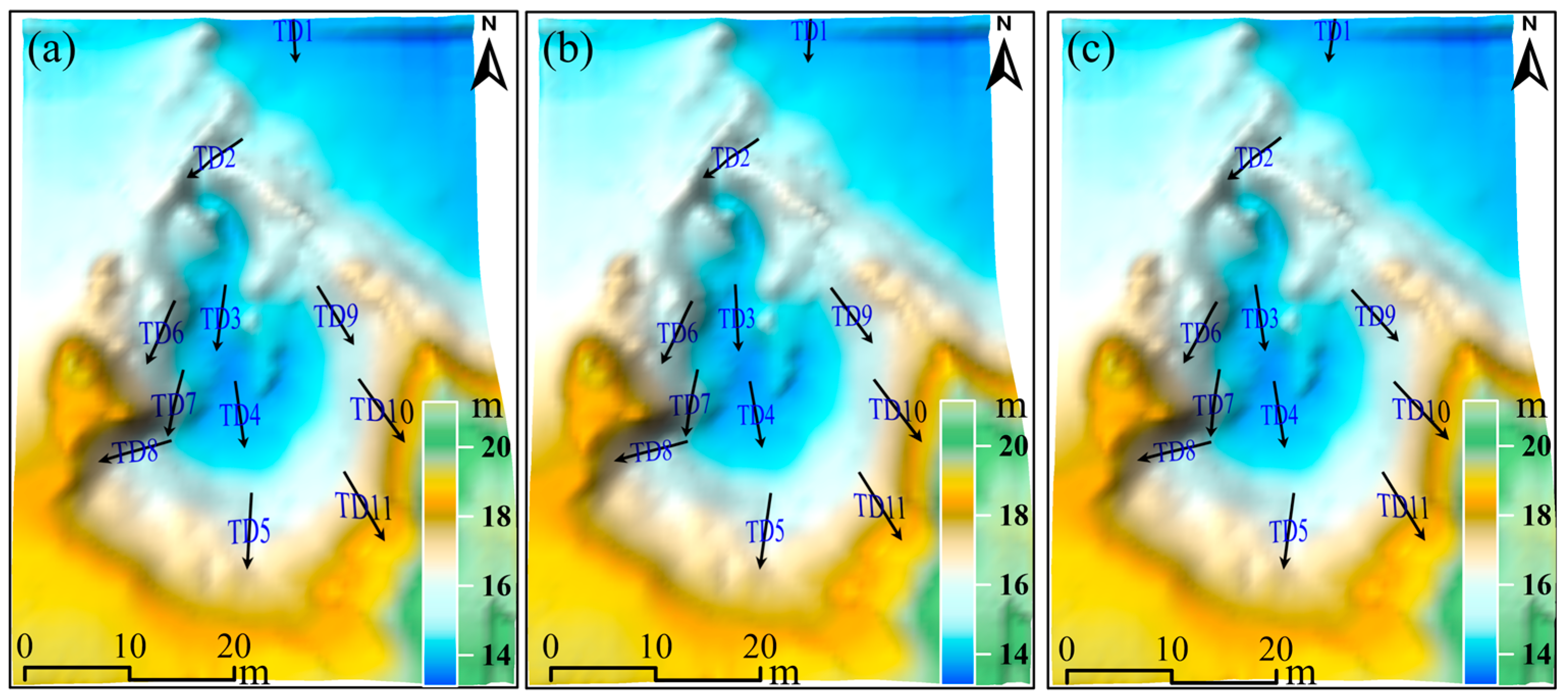
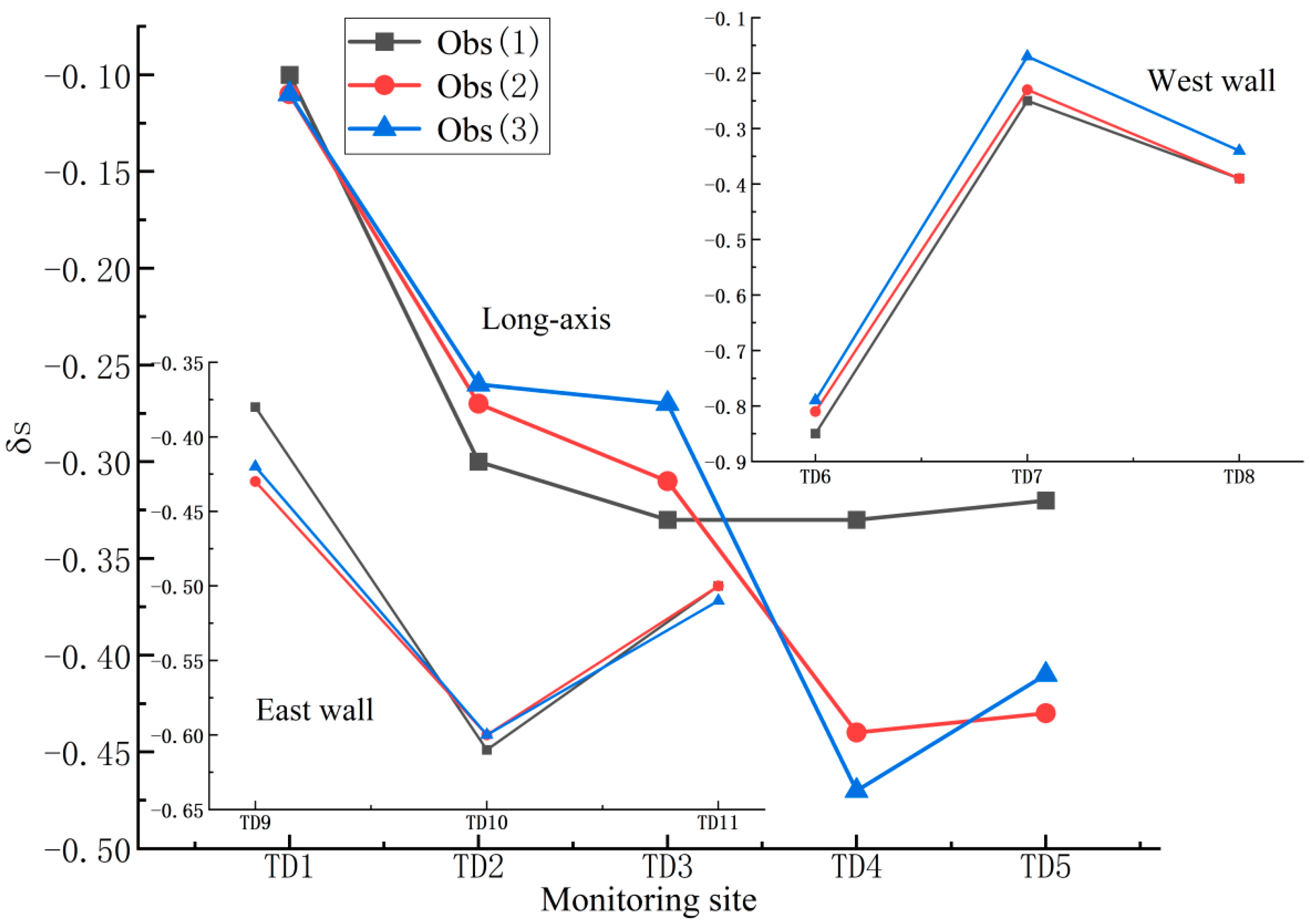
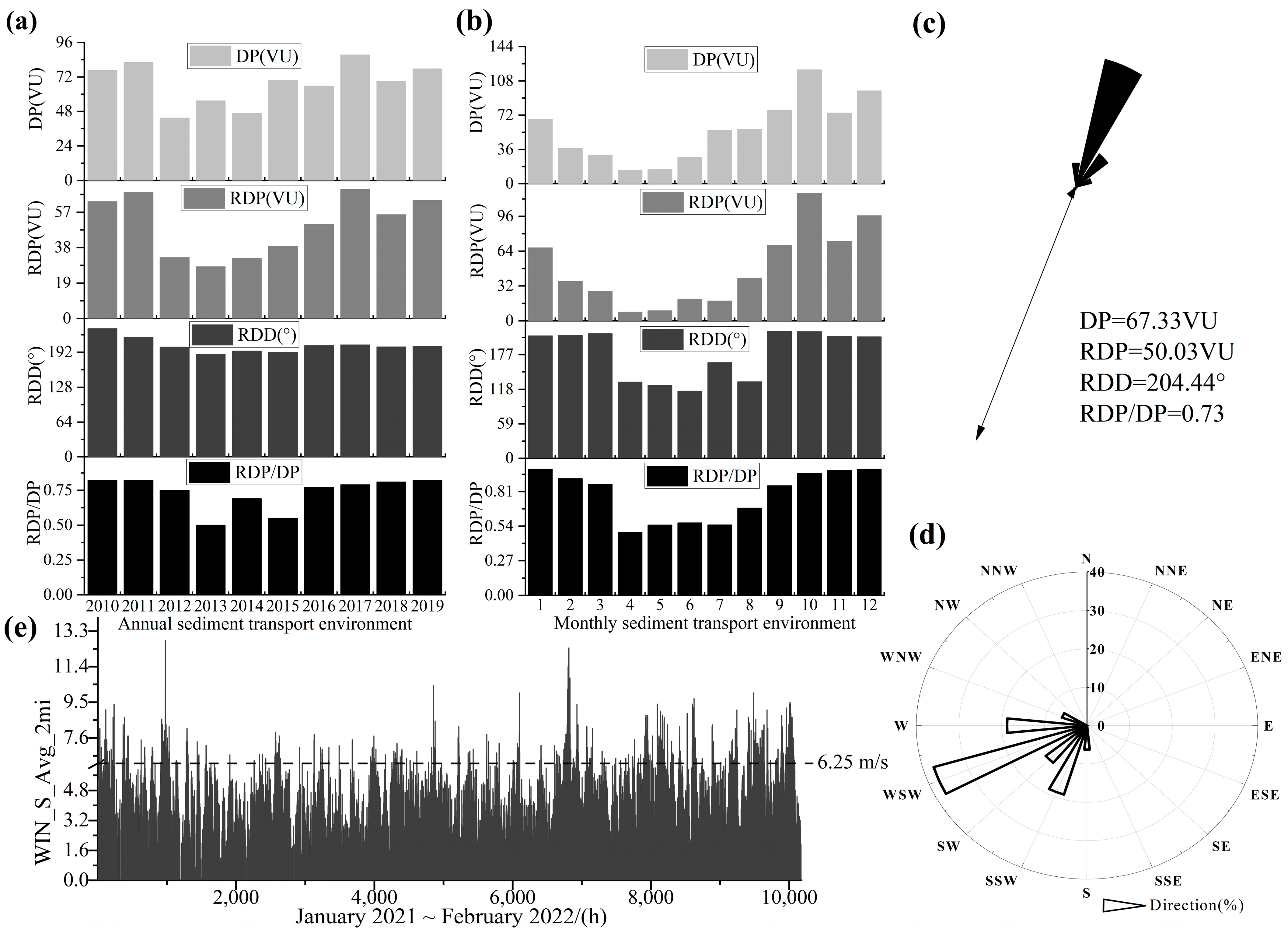
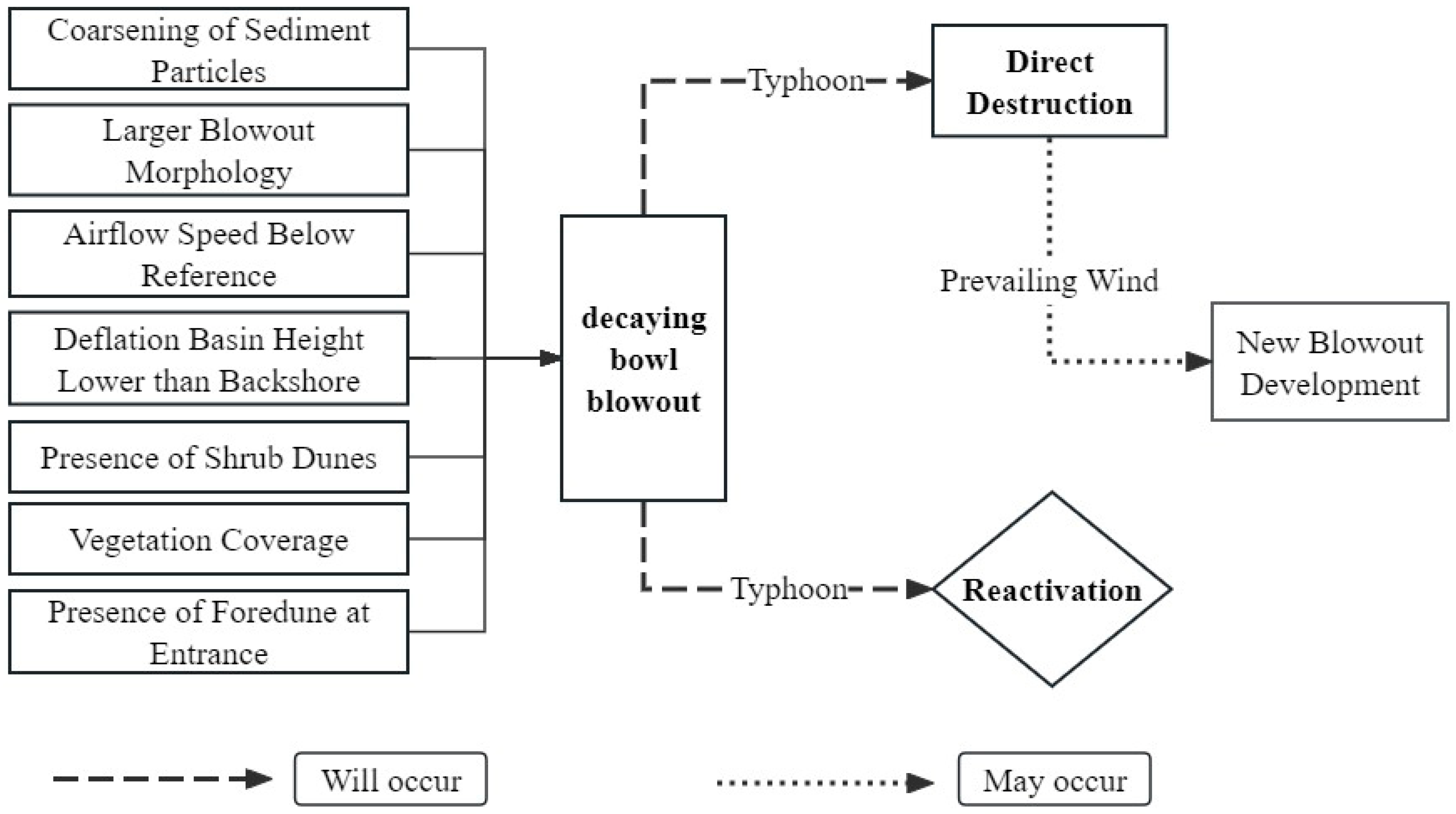
| Observation Time | Approach Wind Direction (°) | Approach Wind Speed (m/s) | Fs | δs |
|---|---|---|---|---|
| Observation 1 | 23 | 10.36 | 0.09 | 0.00 |
| Observation 2 | 29 | 9.97 | 0.09 | 0.00 |
| Observation 3 | 35 | 10.82 | 0.06 | 0.00 |
| Location | Sample | Mz (Φ) | Clay (>8Φ) | Silt (4~8Φ) | V. Fine Sand (3~4Φ) | Fine Sand (2~3Φ) | Medium Sand (1~2Φ) | Coarse Sand (0~1Φ) | V. Coarse Sand (−1~0Φ) | |
|---|---|---|---|---|---|---|---|---|---|---|
| Backshore | TD1 | 1.830 | 0 | 0 | 1.969 | 37.902 | 50.865 | 9.264 | 0.000 | |
| Blowout | Long Axis | TD2 | 1.499 | 0 | 0 | 0.865 | 23.395 | 51.187 | 24.281 | 0.273 |
| TD3 | 1.386 | 0 | 0 | 1.049 | 20.611 | 46.699 | 29.668 | 1.973 | ||
| TD4 | 1.736 | 0 | 0 | 4.927 | 35.242 | 39.596 | 17.675 | 2.559 | ||
| TD5 | 1.480 | 0 | 0 | 3.455 | 26.217 | 39.269 | 26.791 | 4.268 | ||
| Mean | 1.525 | 0 | 0 | 2.574 | 26.366 | 44.188 | 24.604 | 2.268 | ||
| W. lateral wall | TD6 | 2.195 | 0 | 0 | 3.902 | 61.802 | 34.114 | 0.182 | 0 | |
| TD7 | 1.232 | 0 | 0 | 0.081 | 12.835 | 49.666 | 35.756 | 1.662 | ||
| TD8 | 1.896 | 0 | 0 | 4.703 | 41.219 | 42.344 | 11.286 | 0.447 | ||
| Mean | 1.774 | 0 | 0 | 2.895 | 38.619 | 42.041 | 15.741 | 0.703 | ||
| E. lateral wall | TD9 | 1.950 | 0 | 0 | 1.355 | 45.029 | 50.791 | 2.826 | 0 | |
| TD10 | 1.188 | 0 | 0 | 2.293 | 18.185 | 34.864 | 35.673 | 8.985 | ||
| TD11 | 1.046 | 0 | 0 | 1.387 | 9.833 | 39.195 | 43.646 | 5.940 | ||
| Mean | 1.395 | 0 | 0 | 1.678 | 24.349 | 41.617 | 27.381 | 4.975 | ||
| Overall Mean | 1.561 | 0 | 0 | 2.402 | 29.437 | 42.773 | 22.778 | 2.611 | ||
Disclaimer/Publisher’s Note: The statements, opinions and data contained in all publications are solely those of the individual author(s) and contributor(s) and not of MDPI and/or the editor(s). MDPI and/or the editor(s) disclaim responsibility for any injury to people or property resulting from any ideas, methods, instructions or products referred to in the content. |
© 2025 by the authors. Licensee MDPI, Basel, Switzerland. This article is an open access article distributed under the terms and conditions of the Creative Commons Attribution (CC BY) license (https://creativecommons.org/licenses/by/4.0/).
Share and Cite
Zhang, S.; Dong, Y.; Tian, W.; Fu, S.; Yang, L. Morphodynamics and Successional Characteristics of Bowl Blowout in the Late Stage of Coastal Foredune. J. Mar. Sci. Eng. 2025, 13, 638. https://doi.org/10.3390/jmse13040638
Zhang S, Dong Y, Tian W, Fu S, Yang L. Morphodynamics and Successional Characteristics of Bowl Blowout in the Late Stage of Coastal Foredune. Journal of Marine Science and Engineering. 2025; 13(4):638. https://doi.org/10.3390/jmse13040638
Chicago/Turabian StyleZhang, Shaoyun, Yuxiang Dong, Wei Tian, Shuyi Fu, and Lin Yang. 2025. "Morphodynamics and Successional Characteristics of Bowl Blowout in the Late Stage of Coastal Foredune" Journal of Marine Science and Engineering 13, no. 4: 638. https://doi.org/10.3390/jmse13040638
APA StyleZhang, S., Dong, Y., Tian, W., Fu, S., & Yang, L. (2025). Morphodynamics and Successional Characteristics of Bowl Blowout in the Late Stage of Coastal Foredune. Journal of Marine Science and Engineering, 13(4), 638. https://doi.org/10.3390/jmse13040638







